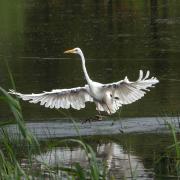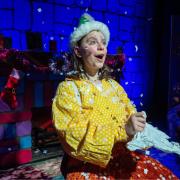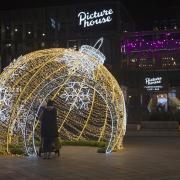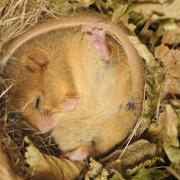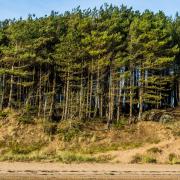Dip beneath the surface and you’ll find UK seas are as diverse as coral reefs and home to a mind-boggling variety of weird and wonderful creatures.
Like the land, the seabed is a patchwork of habitats including sand, mud, gravel, rocky reefs and even huge submarine canyons. From the rocky reefs of Anglesey to the depths of the Lune Deep, the Irish Sea features all of these and more, each supporting its community of species. The sea is a 3D environment, with creatures living in, on and swimming above the seabed.
We begin our journey on the shore, surrounded by habitats we’re familiar with from days out at the seaside. Rock pools are often our first glimpse into the underwater world, where limpets graze films of algae like armoured lawnmowers among dark red Beadlet anemones, their tentacles retracted as they await the next tide. At the foot of the rocks, you might spot what looks like muddy honeycomb – but is, in fact, a living reef. Built by honeycomb worms from sand and shell, the reef structures provide shelter for other species like snails, crabs and anemones. Subtidal rocky reefs are home to many fish species, including the rainbow-coloured male cuckoo wrasse, an inquisitive species that wouldn’t look out of place on a tropical reef.
The sand beneath your deck chair is full of life too. Many types of worm, bivalve (shells) and crustacean live among the sand grains but obvious evidence of their secretive lives is limited to the shells of dead organisms or, in the case of lugworms, from their sandy casts. The wealth of invertebrates found in our estuaries and mudflats, however, is clear from the hundreds of thousands of wading birds – knot, dunlin and redshank for example – that overwinter on our shores. Did you know that one cubic metre of estuarine mud has the same calorific content as 16 Mars bars?
Moving offshore, the Irish Sea’s habitats are no less exciting. Vast plains of mud support delicate sea pens – a type of soft coral resembling an antique quill – alongside prickly sea urchins, spiny spider crabs and the delicious Dublin Bay Prawn (AKA scampi). The submarine patchwork also features plentiful sand and gravel habitats that are important spawning and nursery grounds for fish, including flatfish, the (not so) common skate and sea bass. Sand and gravel are also home to sand eels, an important prey species for many commercially important fish, including cod and haddock, and for seabirds such as puffins. This resource also attracts larger predators, such as harbour porpoise and some of the 30 species of shark found in the Irish Sea.
Moving upwards in the water column lies the foundations of this rich marine foodweb – plankton. This saltwater cocktail is made up of microscopic, photosynthetic algae (phytoplankton), tiny creatures such as copepods (which form the greatest animal biomass on Earth) and the eggs and larvae of most marine species. Excitingly, it is this smallest of life that attracts one of the biggest visitors to the Irish Sea – the world’s second-largest fish – the basking shark. This filter feeder arrives to feast on plankton blooms and the Isle of Man is thought to be an important breeding habitat for the species, with courtship rituals visible from shore during the summer months. The summer swarm of jellyfish also brings some rather large, exotic visitors to our seas, namely the leatherback turtle and the ocean sunfish – the world’s largest turtle and bony fish respectively.
These are not the only ocean giants to visit the Irish Sea. Twelve species of cetacean have been recorded in local waters including the diminutive harbour porpoise, gregarious bottlenose dolphin and even the majestic killer whale. Grey and common seals are also found locally, often spotted basking on rocks or sandbanks at favourite sites around the North West.

SEEING SEA LIFE
You don’t have to be a scuba diver to see marine wildlife. There are lots of ways to get up close with sea life
Rockpooling
Offshore from West Kirby on the Wirral lies the Hilbre Island group, where some of the region’s best rockpools can be explored at low tide. Contact the Wirral Council Rangers for guidance on crossing times. New Brighton offers a more easily accessible option, with pools around Fort Perch Rock yielding plentiful surprises including some fantastic honeycomb reefs.
Spot the seals
Did you know that the largest aggregation of seals in the Irish Sea can be found in the Dee Estuary? Up to 700 grey seals have been seen hauled out (resting) on the estuary’s sandbanks at low tide. Head over to Hilbre Island to see them resting at low tide.
Ocean giants
Harbour porpoises, the smallest cetacean found in UK waters, can be spotted in Liverpool Bay. On a calm day, look out for their small triangular fin breaking the surface. Much more obvious are the sickle-shaped fins of bottlenose dolphins, often seen travelling in pods. If you see two wide triangular fins continually at the surface, you’re looking at a basking shark. High tide at Hilbre Island or New Brighton is your best bet for seeing ocean giants.
Our Dee Estuary is a Tidal Dee Catchment Partnership project designed to inspire coastal communities on the Wirral and in Flintshire and Denbighshire about the natural heritage of the Dee Estuary and led by Cheshire Wildlife Trust and supported by The National Lottery Heritage Fund. Find out more: cheshirewildlifetrust.org.uk/ourdeeestuary






